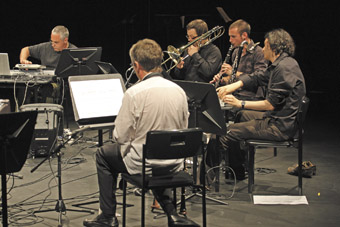musical miracles
greg hooper: elision, heliocentric

Elision
photo Justin Nicholas
Elision
ELISION RECENTLY GOT TURFED OFF THE ‘GRAVY TRAIN’ OF QUEENSLAND GOVERNMENT ART LARGESSE (NOT MUCH ROOM FOR A SUPPING SPOON IN THAT TINY BOWL) SO THIS CONCERT WAS PROBABLY THEIR LAST IN BRISBANE BEFORE MOVING BASE TO MORE SUPPORTIVE CLIMES. BESIDES NEW PIECES FROM RICHARD BARRETT (UK) AND TIMOTHY MCCORMACK (USA), THE CONCERT WAS AN OPPORTUNITY TO HEAR FROM THE NEW (AUSTRALIAN RESEARCH COUNCIL FUNDED) COLLABORATION WITH LAWRENCE HARVEY’S SOUND GROUP AT RMIT’S EVER INTERESTING SPATIAL INFORMATION ARCHITECTURE LABORATORY (SIAL).
McCormack’s Disfix for bass clarinet, piccolo trumpet and trombone opened the show. The work deconstructs instrumental playing technique into a set of parameters that can work with or against each other. Note from score: “The physical awkwardness and resulting aural distortion of the material implicit in this situation is quite deliberate and intended.” Disfix starts with the three performers standing and facing each other in a close group. Pleasant sounds pop about in a mild, gently hysterical frenzy. Parts break up, jump from one performer to another and then come tightly together in parallel. Phrases are short, silences are brief. Lots of talking and singing through the instruments. Again from the score: “It is of the utmost importance that the performer treats the voice part as an autonomous domain.” That’s while the performer tosses off a few other autonomous virtuosities and keeps time-synched with the others! By the end it all hangs together to give an overall movement from disjunction to cohesion. A difficult work brilliantly played; I could easily listen to it again.
Richard Barrett has been working with Elision for many years and this intimate knowledge of the performers showed in his structured improvisation, Codex IX. A core of the ensemble’s regulars are joined by Joel Stern (and Barrett) on electronics and Jeff Hannam and Michael Hewes, who mix a live feed into speakers set up around and above the audience and performers. The group sits in a wide-ish circle, audience at a tangent on two sides. Sub-bass drones start up with an overlay of light, subtle percussion. Ratchet sounds, more drones, then a burst of tight synchronisation in response to Barrett jabbing out some conducting moves. New section, freeform again, more drones, ululating winds, spatialised percussion. Viola with a string-rubbed roaring. More sections. Loud, soft. Insects and the banging of a screen door. Oboe and clarinet, like a miracle, walk amongst us.
At times electronics or other instruments crack a solo, but overwhelmingly Codex IX is an ensemble piece. Phrases trade across from performer to performer—maybe picking up on the timbre, maybe tracing the pitch movement. The spatialisation is subtle, widening the sound at times, and other-times delaying and shifting a part as though it were echoed by another performer. Similarly the electronics work of Stern and Barrett gives no sense of the tech being bolted on. Notes are picked up, harmonies added in, parts elaborated. So seamless it can be difficult to hear who is playing what. Smooth as can be.
It is ridiculous that a group of this quality had its funding cut by the Minister responsible for the Arts in Queensland. Then again, I can’t find any mention of art or music in the list of personal interests on his Arts Queensland website (www.arts.qld.gov.au/aboutaq/minister.html)
Elision Contemporary Music Ensemble, heliocentric, composers Richard Barrett, Timothy McCormack, performers: oboe Peter Veale, clarinet Richard Haynes, trumpet Tristram Williams, trombone Benjamin Marks, percussion Peter Neville, electric guitar Daryl Buckley, live electronics Richard Barrett, Joel Stern, violin Graeme Jennings, viola Erkki Veltheim, sound spatialisation Jeff Hannam, Michael Hewes, Judith Wright Centre of Contemporary Arts, Brisbane, Oct 4
RealTime issue #88 Dec-Jan 2008 pg. 45






